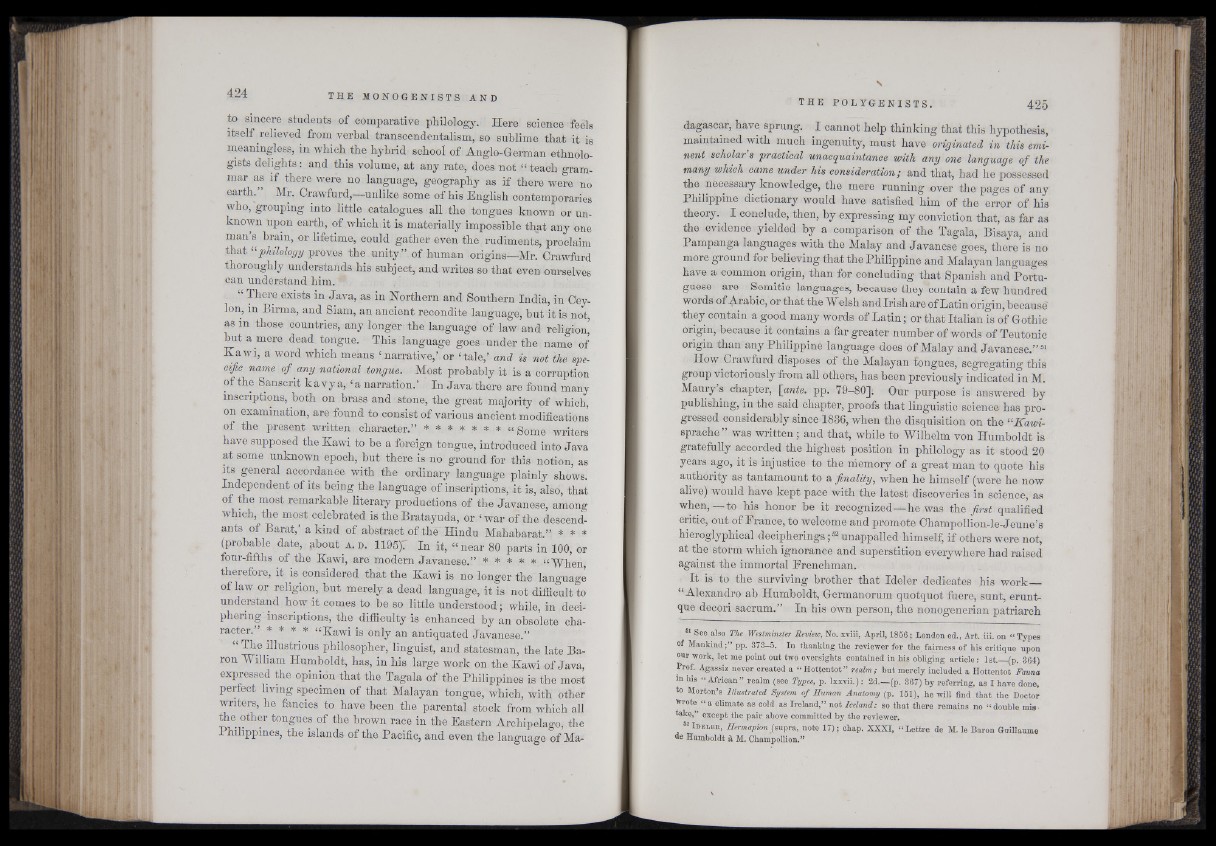
to sincere students of comparative philology. Here science feels
itself relieved from verbal transcendentalism, so sublime that it is
meaningless, in which the hybrid school of Anglo-German ethnologists
delights: and this volume, at any rate, does not “ teach grammar
as if there were no language, geography as if there were no
earth.” Mr. Orawfurd,—unlike some of his English contemporaries
who, grouping into little catalogues all the tongues known or unknown
upon earth, of which it is materially impossible that any one
man’s brain, or lifetime, could gather even the rudiments, proclaim
that “philology proves the unity ” of human origins—Mr. Crawfurd
thoroughly understands his subject, and writes so that even ourselves
can understand him.
'There exists in Java, as in ^Northern and Southern In dia, in Ceylon,
in Birma, and Siam, an ancient recondite language, but it is not,
as m those countries, any longer: the language of law and religion'
but a mere dead, tongue. This language goes under the name of
Kawi, a word which means ‘narrative,’ or ‘tale,’ and is not the specific
name of any national tongue. Most probably it is a corruption
of the Sanscrit kavya, ‘a narration.’ In Java there are found many
inscriptions, both on brass and stone, the great majority pf which,
on examination, are found to consist of various ancient modifications
of the present written, character.” * * * * * * * “ Some writers
have supposed the Kawi to be a foreign tongue, introduced into Java
at some unknown epoch, but there is no ground for this notion, as
its general accordance with the ordinary language plainly shows.
Independent of its being the language of inscriptions, -it is, also, that
of the most remarkable literary productions of the Javanese, among
which, the most celebrated is the Bratayuda, or I war of the descendants
of Barat,’ a kind of abstract of the Hindu Mahabarat ” * * *
(probable date, about _ a . d . 1195)7 In it, “ near 80 parts in 100, or
four-fifths of the Kawi, are’modern Javanese.” * * * * * “When
therefore, it is considered that the Kawi is no longer the language
of law or religion, but merely a dead language, it is not difficult to
understand how it comes to he so little understood ; while, in deciphering’inscriptions,
the difficulty is enhanced by an obsolete character.
* * * * “Kawi is only an antiquated Javanese.”
“ The illustrious philosopher/linguist, and statesman, the late Baron
'William Humboldt, has, in his large work on the Kawi of Java,
expressed the opinion that the Tagala of the Philippines is the most
perfect living specimen of that Malayan tongue, which, with other
writers, he fancies to have been the parental stock from which all
the other tongues of the brown race in the Eastern Archipelago, the
Philippines, the islands of the Pacific, and even the language of Madagascar,
have sprung. I cannot help thinking that this hypothesis,
maintained with much ingenuity, must have originated in this eminent
scholar’s practical unacquaintance with any one language of the
many which came under his consideration; and that, had he possessed
the necessary knowledge, the mere running over the pages of any
Philippine dictionary would have satisfied him of the error of his
theory. I conclude, then, by expressing my conviction that, as far as
the evidence yielded by a comparison of the Tagala, Bisaya, and
Pampanga languages with the Malay and Javanese goes, there is no
more ground for believing that the Philippine and Malayan languages
have a common origin, than for concluding that Spanish and Portuguese
are Semitic languages, because they contain a few hundred
words of .A rablo, or that the W elsh and Irish are of Latin origin, because
they contain a good many words of Latin; or that Italian is of Gothic
origin, because it contains a far greater number of words of Teutonic
origin than any Philippine language does of Malay and Javanese.”51
How Crawfurd disposes of the Malayan tongues, segregating this
group victoriously from all others, has been previously indicated in M.
Maury’s chapter, [ante. pp. 79-80]; Our purpose is answered by
publishing, in the said chapter, proofs that linguistic science has progressed
considerably since 1836, when the disquisition on the “Kawi-
spraehe” was written; and that, while to Wilhelm von Humboldt is
gratefully accorded the highest position in philology as it stood 20
years ago, it is injustice to the memory of a great man to quote his
authority as tantamount to a finality, when he himself (were he now
alive) would have kept pace with the latest discoveries in science, as
when,—to his honor be it recognized—he was the first qualified
critic, out of France, to welcome and promote Champollion-le-Jeune’s
hieroglyphical decipherings;52 unappalled himself, if others were not,
at the storm which ignorance and superstition everywhere had raised
against the immortal Frenchman.
It is to the surviving brother that Ideler dedicates his work__
“Alexandra ab Humboldt, Germanorum quotquot fuere, sunt, erunt-
que decori sacrum.” In his own person, the nonogenerian patriarch
61 See also The Westminster Review, No. xviii, April, 1856; London ed., Art. iii. on “ Types
of Mankind;” pp. 373-5. In thanking the reviewer for the fairness of his critique upon
our work, let me point out two oversights contained in his obliging article: 1st. (p. 364)
Prof. Agassiz never created a “ Hottentot” realm; but merely included a Hottentot Fauna
in his “ African” realm (see Types, p. lxxvii.): 2d— (p. 367) by referring, as I have done,
to Morton’s Illustrated System of Human Anatomy (p. 151), he will find that the Doctor
vrote “ a climate as cold as Ireland,” not Iceland; so that there remains no “ donble mistake,”
except the pair above committed by the reviewer.
52 I d e l e r , Hermapion jsupra, note 17); chap. XXXI, “ Lettre de M. le Baron GuHlaume
do Humboldt A M. Champollion.”